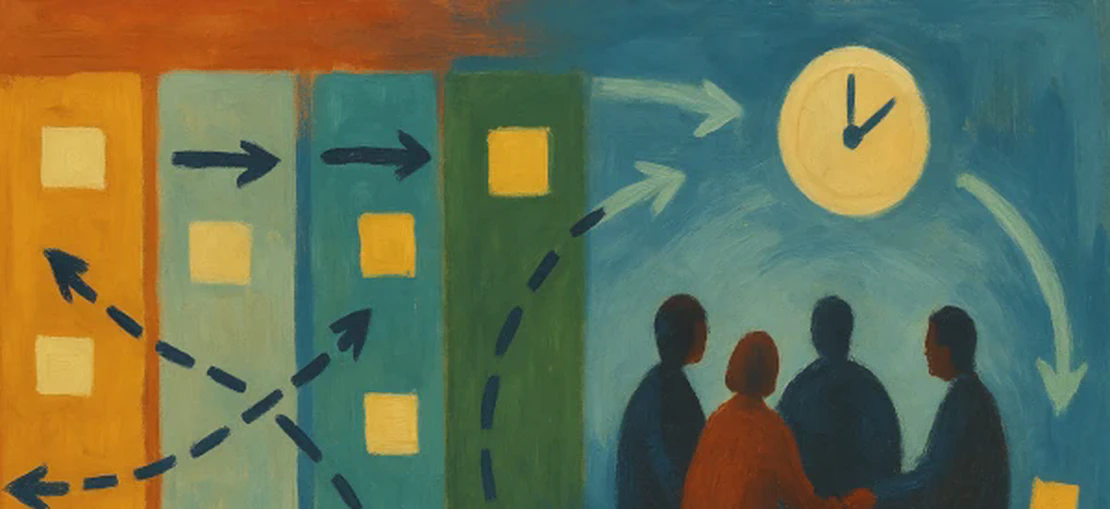How to Run a Successful Daily Scrum.
There are a lot of complaints that the Daily is just a status check for a boss to micromanage. In this post, we’ll clarify what the Daily is (and isn’t), why it often drifts into reporting, and how to run a short, useful coordination meeting instead.
What the Daily Scrum is for
The Daily exists so the team can inspect progress toward the Sprint Goal and adapt the plan for the next 24 hours. That’s it.
- Timebox: max 15 minutes.
- Audience: the Developers talk to each other.
- Outcome: a clear, shared plan for today.
A simple agenda (15 minutes)
- Set the frame (1 min). “Our Sprint Goal is X. We’re about ~80% there. Any new risks?”
- Walk the board right → left (10–12 min).
- Done → quickly verify acceptance.
- Almost done → what’s needed to finish today? Who pairs?
- Blocked → confirm owner + helper + follow‑up time after the Daily. Don’t solve it now.
- In progress → keep WIP small and consider finishing the most valuable item.
- Micro‑plan & handshakes (2–3 min).
- “Who’s pairing on A at 10:00?”
- “We expect B in review by 15:00.”
- “C is at risk. We’ll cut scope unless X happens.”
Rule of thumb:
- Developers talk to each other.
- Scrum Master protects the timebox and flow.
- Product Owner listens for goal risk and clarifies scope.
Why Dailies slip into status reporting
- Legacy of the “three questions.” People default to yesterday/today/blockers and forget the real question: “Are we on track to the Sprint Goal?” If collaboration happens only in the Daily, those three answers become the only signal.
- Updates directed at a single person. When everyone performs for a manager or PO, it becomes status theatre instead of team planning.
- No clear Sprint Goal. Without a shared target, the only thing left to discuss is individual activity.
- High WIP & isolated work. Ten people on ten separate items → ten mini standups, zero coordination.
- Low psychological safety. It’s easier to narrate tasks than to admit risk, ask for help, or propose a change.
- Daily as the only comms channel. If teammates learn important info for the first time in the Daily, comms are broken elsewhere.
In general, nothing in the Daily should be brand‑new information. It should synchronize what the team already knows and finalize today’s plan.
Blockers: don’t wait for tomorrow
If you get blocked at 11:10, you ask for help at 11:10—not tomorrow.
- “Fast help” policy. A #help channel where someone commits to respond within ~30 minutes.
- Buddy/on‑call helper. Rotate each Sprint so support work is shared fairly.
- Visible metrics. Track blocked age on the board and set WIP limits that force finalizing.
- Pair/mob bursts. Use short, focused collaboration to solve tough problems.
Prepare for the Daily (so it stays at 15 minutes)
- Async check‑in beforehand. Update cards and statuses so the live call focuses on coordination, not typing.
- Share the board. Screen‑share (remote) or gather at the same board (in person).
- Rotate facilitator weekly. Use a timer. Keep the flow moving.
- Inclusion: invite quieter voices.
- One‑conversation rule: only one thread at a time. Park side topics for after.
During the Daily
- Don’t solve problems in the meeting. Schedule a follow‑up with only the relevant people.
- Adapt the plan to hit the Sprint Goal.
- Walk the board right → left and keep it moving.
- Surface blockers (they should have been raised earlier, but this is the last safety net).
- Limit WIP. You won’t finish more by starting more. Finish item by item.
Lightweight metrics (used for learning, not policing)
- Aging WIP: items lingering in “In Progress.”
- Blocked time per item and time‑to‑first‑help.
- % of Daily time spent on Sprint‑Goal items vs. generic updates.
- WIP count vs. your WIP limit.
- Flow efficiency (optional): value‑adding time vs. waiting.
Working agreement (copy/paste)
- Purpose: In 15 minutes we adapt the plan to hit the Sprint Goal.
- Flow: We walk the board right→left and don’t problem‑solve.
- Help: Blockers are asked immediately. Someone responds within 30 minutes.
- WIP: Limit in‑progress items. Prefer finalizing task over starting new one.
- Prep: Update your cards before the Daily.
- Etiquette: One‑conversation rule. make space for quiet voices.
Try this tomorrow (script)
- “Today I’m helping move [Card‑123] to Done by doing X with Y. Risk: Z.”
- “I need help on [Card‑456]. Y and I will sync at 13:00 for 20 minutes.”
- “I propose we pause [Card‑789] and finish the highest‑value item.”
Can the Daily be shorter—or async?
Some days it’ll take six minutes. Great—end early. For heavy time‑zone splits, an async check‑in can work, but keep a short live sync 2–3 times a week to maintain teamness and catch nuance.
Recap
The Daily is a coordination checkpoint, not a status ceremony. Keep comms flowing all day, raise blockers immediately, and use the Daily to sharpen the team’s plan—not to perform for a manager.
